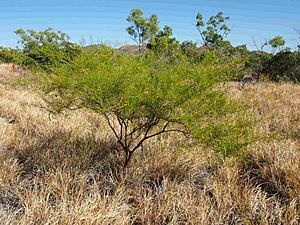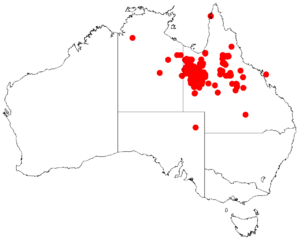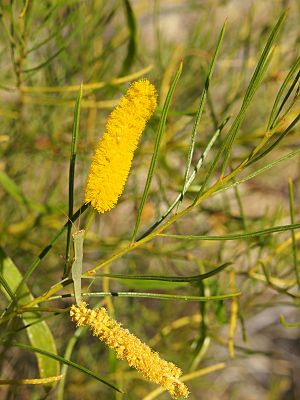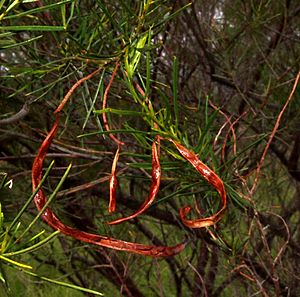Acacia chisholmii facts for kids
Quick facts for kids Turpentine bush |
|
|---|---|
 |
|
| A. chisholmii habit | |
| Scientific classification | |
| Genus: |
Acacia
|
| Species: |
chisholmii
|
 |
|
| Occurrence data from AVH | |
Acacia chisholmii, often called the turpentine bush or Chisholm's wattle, is a type of shrub. It belongs to the large group of plants known as Acacia (wattles). This plant is native to the dry, arid parts of northeastern Australia.
What Does the Turpentine Bush Look Like?
This shrub has many stems and can grow up to 4 m (13 ft) (about 13 feet) tall. Its bark looks like "minni ritchi" bark, which means it peels off in thin, curly strips. The branches are often purplish-brown or reddish-brown. They have small, wavy edges and tiny, flattened hairs.
The turpentine bush flowers between May and August. It produces bright golden flower spikes that are about 13 to 28 mm (0.51 to 1.10 in) long. After the flowers, it grows long, flat seed pods. These pods are squeezed in between each seed. They can be 2.5 to 14 cm (0.98 to 5.51 in) long and have lighter edges. Inside the pods are dark brown or black seeds. These seeds are usually long and oval-shaped, measuring about 3.6 to 4.5 mm (0.14 to 0.18 in) in length.
How Scientists Name Plants
Scientists give plants special names to help identify them. This is called taxonomy. The Acacia chisholmii was first officially described in 1899. A botanist named Frederick Manson Bailey gave it its first scientific description.
Later, in 1987, another botanist, Leslie Pedley, changed its name to Racosperma chisholmii. But in 2001, it was moved back into the Acacia group. Sometimes, a plant can have more than one scientific name that means the same thing; this is called a synonym. For this plant, Acacia costinervis is another name it was once known by.
The turpentine bush is closely related to other Acacia species. These include Acacia lysiphloia, Acacia trachycarpa, Acacia effusa, and Acacia gracillima. It can even mix with Acacia monticola to create new types of plants.
Where Does the Turpentine Bush Grow?
You can find Acacia chisholmii mostly in the western parts of Queensland, Australia. It is very common around the Mount Isa and Cloncurry areas.
This plant likes to grow on stony plains, especially those with a type of soil called laterite. It also grows in areas with shallow, sandy soils. You might see it in rolling hills or on steep slopes. It often grows as part of grasslands or in woodlands. These woodlands usually have Eucalypt trees and spinifex grasses. Smaller groups of these plants are also found in the far eastern parts of the Northern Territory, near Lake Nash.



